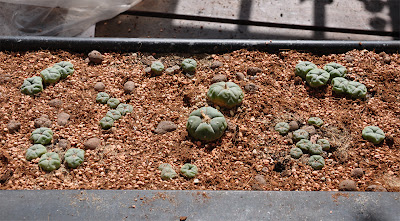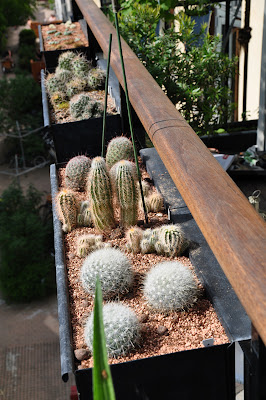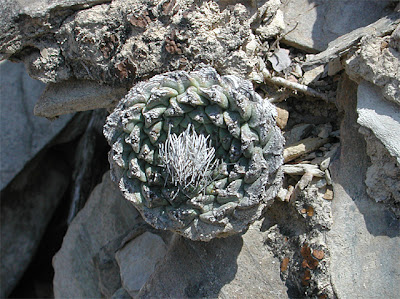
Snow covered cacti growing in window boxes
As mentioned in an earlier post I'm experimenting with growing peyote (and other cacti) outdoors on my balcony. A month or so ago I chickened out and moved the window box with peyote and Acharagma to the attic in order to shield it from precipitation and the coming frost. Today I'm glad I did as the balcony (and the flower boxes with it) has been completely covered in snow for the last couple of days - and I'm not sure if that would become the peyote plants well.

Echinocereus triglochidiatus covered by snow (with E. reichenbachii in the background)
I'm pretty sure that the hardy Echinocereus triglochidiatus will make it through the outdoor winter experience, and I'll also put money on the Escobaria vivipara (Alberta, Canada) and Escobaria missouriensis (SB204; Mesa County, Colorado) plants as they have already survived a winter outdoors, but I have my doubts about the Echinocereus reichenbachii plants as this is the first time I grow them under such extreme conditions.

Snow covered Mammillaria grahamii
Other doubts are regarding the Mammillaria grahamii (SB 1860; Steins, New Mexico, USA) and Mammillaria senilis (ROG 214; Tecorichi, Chihuahua, Mexico) plants as I'm very unsure if they are able to survive conditions like this. We'll know come spring.

Snow covered Mammillaria senilis
Thursday, January 30, 2014
Snow covered cacti on the balcony
Saturday, June 08, 2013
Growing peyote (and other cacti) on the balcony
40 peyote cacti growing in a window flower box
For the last many years I've experimented with growing peyote, Ariocarpus, Leuchtenbergia, and the likes in an unheated coldhouse in Denmark. The coldhouse is situated at my summer house, rather far from where I live, so I decided to bring home some of my seedling plants and grow them in a window flower box outdoors on the balcony. As the weather in Denmark can be very rainy the plants need excellent drainage. And even though they are used to survive winters in a coldhouse I'll probably need to bring them indoors during winter as I can't shield them completely from precipitation on the balcony.
Flower box planted with peyote and Acharagma
I waited for a sunny period (and a ditto long term weather report :-) before planting a window box with 40 peyote plants and a handful each of Acharagma aguirreana and Acharagma roseana plants.
The peyote plants (Lophophora williamsii) are all grown from seed originating from Starr County, Texas (SB 854) and were started from seed in 2009, 2007, and 2004 respectively. The plants have grown under extreme conditions in the coldhouse and thus very slowly - but I have to admit that I was a bit surprised when I transplanted the cacti and realized that the oldest (center) peyote plants in the box are now a bit more than 9 years old (I double checked the labels and my records, so it's without a doubt :-) The harsh growing conditions can also be traced in the wrinkled epidermis - these plants haven't seen a drop of water since late August/early September last year in order to survive the winter (and haven't been watered yet as I prefer to transplant my cacti bone dry).
Both Acharagma species were started from seed in spring 2009.
Drainage layer of Leca pebbles
I have never grown this type of cacti in window flower boxes before and was very much in doubt of what type of soil to use.
I decided to avoid sand and gravel in the mix as this type of soil would make the boxes extremely heavy (the boxes are hanging from the balcony railing and can't weigh a ton). Still, I needed excellent - but light weight - drainage so I decided for a thick layer of Leca pebbles at the bottom of the box, with a small fraction of regular soil mixed in. Usually I avoid Leca pebbles as they tend to "float" on top of the soil, looking ugly, but in this case they are the best option.
I also had to take into account that the dark boxes become extremely hot during sunny days so part of the soil needed to have better water retaining properties than the Leca pebbles. My solution was to use a top layer consisting of burnt moler cat litter and coir (a natural fibre extracted from the husk of coconut) - both are able to retain water but don't get soggy and waterlogged.
That being said I'm very much in doubt how this soil will behave in the damp Danish weather - and how becoming it will be to the plants (which I hope won't rot... but I'm sure time will tell :-)
Flower box planted with Echinocereus reichenbachii and Mammillaria
Another flower box was planted with Echinocereus reichenbachii originating from material I collected in the Wichita Mountains Wildlife Refuge back in 2007 plus a few Mammillaria grahamii (SB 1860; Steins, New Mexico, USA) and Mammillaria senilis (ROG 214; Tecorichi, Chihuahua, Mexico) plants bought from Kakteen-Haage.
I don't have much experience with growing Mammillaria species but selected these plants for their ability to tolerate cold conditions - and also for their beautiful flowers of course :-) One thing I learnt the hard way is that the fish hook spines of the Mammillaria plants behave like velcro when the plants get too close to each other, i.e. you should be very careful when planting several plants in the same container.
Three cacti window flower boxes on a row
I now have a total of three window flower boxes planted with cacti on the balcony; the two covered in this post plus the box planted with Echinocereus triglochidiatus, Escobaria vivipara (Alberta, Canada), and Escobaria missouriensis (SB204; Mesa County, Colorado). The latter box was planted last year and wintered outdoors on the balcony.
Sunday, April 11, 2010
The killing frost – casualties and survivors
First a bit of background information so that you guys won’t believe that I am completely stupid growing Lophophora and the likes in an unheated greenhouse in Denmark: 1) Most of these plants are “surplus”, i.e. I don’t have room for them anywhere else – lately several plants have been bought specifically for the cold house, though. 2) The greenhouse is located at my summerhouse, left mostly desolate throughout winter, making it difficult to keep it reliably heated. 3) Many cactus species tolerate more frost than is generally assumed; I’m curious which. 4) The winters in Denmark have been rather mild lately, inviting experiments like this.
With this in place I’m ready to recount how the harsh winter, that has just released its cold grip of Denmark, helped me separate the wheat from the chaff (a blatant euphemism for “killing off alarmingly large parts of my collection”). Just to give an understanding of the severity of the winter, the plants saw almost constant frost for more than 10 weeks, with temperatures measured as low as -15 C (5 F) in the area where the plants grow.
Lophophora williamsii var. echinata coming out of winter
Let’s start with one of the success stories. My Trans-Pecos peyote plants are doing quite well, approximately one in eight died and the surviving plants are not too marked by the frost. The plants I'm growing are descending from material originally collected in the Pecos River area, Val Verde County, Texas (JJH 8608293). The Trans-Pecos peyote is the northernmost form of Lophophora williamsii and is also known as Lophophora williamsii var. echinata.
Trans-Pecos peyote surviving the frost
My regular (Mexican and south Texan) Lophophora williamsii plants fared much worse, less than one in ten of the larger plants survived the winter. 
One of the few surviving Lophophora williamsii var. williamsii
This corresponds well with Del Weniger’s observations:
[Lophophora williamsii var. echinata] can also survive the much more severe cold of the Big Bend. I have several times had the smaller form from south Texas [L. williamsii var. williamsii] freeze in San Antonio, while this form [L. williamsii var. echinata] growing in the same bed showed no ill effects.
In the future I'll focus more on the extreme northern forms of peyote, i.e. plants grown from material originating from Shafter, Val Verde, Big Bend and other Trans-Pecos, Texas locations. The Cactus Conservation Institute has an informative page on the differences in traits between Lophophora williamsii var. echinata and var. williamsii.

Frost killed Lophophora williamsii, Starr County, Texas
As mentioned the majority of my large “regular” Lophophora williamsii were killed by the frost. But many medium sized seedling plants actually survived while the larger plants (of the same variety) and yearling seedlings succumbed. As this pattern seems to be rather consistent for plants of the same variety, I guess I can’t write all “regular” Lophophora williamsii casualties off to genetics. My theory is that this “size-conditioned” difference in survival must be related to how well the plants were prepared for the winter, which again may be closely related to the surface-area-to-volume ratio of the plant.
The surface-area-to-volume ratio (SA:V) decreases with size, i.e. a large plant will have less surface per unit of volume than a smaller plant. If we use a half sphere as a model for a globular cactus we get a SA:V of 3/r, where r is the radius. Consequently a large plant will need relatively longer time (per unit of volume) to go flaccid and prepare properly for the winter (as all excess water needs to be evaporated through the surface (the epidermis)). Similarly seedlings are more prone to die of drought as an increased SA:V means increased exposure to the environment in general.
To play it safe the coming growing seasons I'll stop watering my large plants well before I let seedlings go drought dormant in preparation for the winter, and in general start winter preparations earlier than I have used to in the past.
I might consider crossing the surviving mature (non Trans-Pecos) plants and name the cultivar Lophophora williamsii 'Borealis' ;-)

Frost killed Leuchtenbergia principis – outside the rain is weeping
My largest Leuchtenbergia principis is dead (pictured above next to a surviving saguaro) while 3 out of 4 of my smaller Leuchtenbergia principis plants (GL 770; Sierra de la Paila) are looking happy.
Ariocarpus has turned out to be an unconditional coldhouse success. I expected my Ariocarpus fissuratus plants to make it safely through the winter as they originate from locations like Fort Stockton, Texas (JM 122) and Crockett County, Texas (SB 403), but I had doubts about my Ariocarpus kotschoubeyanus var. macdowellii plants (SB 100; El Pilar, Coahuila), and had accepted that I would probably loose my Ariocarpus retusus (SB 310; Cuesta la Muralla, Coahuila). Amazingly they all survived the winter in great style almost looking lush and vigorous, like a winter swimmer surfacing with renewed energy after a cold plunge.

Surviving Ariocarpus, Epithelantha, and Leuchtenbergia plants
Epithelantha is another seriously cold tolerant genus. My Epithelantha micromeris var. greggii plants (Cuesta la Muralla, Coahuila, Mexico) all made it; one is seriously damaged, though – it looks like the root is dead while the crown looks fine, so I hope to be able to re-root it. The Epithelantha bokei plants (SB 416; Brewster Co, Texas) also look fine, but due to the extremely dense spination it is hard to say for sure if they are completely undamaged. Strangely the cold has taken the hardest toll on my regular Epithelantha micromeris (SB1327; near Belen, New Mexico) – this variety of E. micromeris is from the northernmost known locality of the species so I had expected the plants to cope better with the frost.

Surviving Obregonia denegrii plants
Last summer I moved a handful of Obregonia denegrii seedlings (VVZ 163; San Vicente, Tamaulipas) to the coldhouse. I really didn’t expect these plants to be cold hardy, but didn’t have room for them anywhere else. Surprisingly approximately two thirds of the plants survived as illustrated in the above picture (the surrounding pots are not empty, each contain a rather large L. williamsii killed by the cold).
Other success stories are Normanbokea valdeziana, Homalocephala texensis, and Mammillaria meiacantha which all made it through the winter without casualties – the Normanbokea plants are even budding. Acharagma roseana is another species that’s shaking off the winter blues and getting ready to bloom – in general Acharagma seems to handle the cold pretty well, even most of my yearling Acharagma aguirreana seedlings survived. Most Escobaria and Echinocereus obviously had minimal problems with the frost.

Frost killed Lophophora williamsii turning to mush
As mentioned above the majority of my larger, regular Lophophora williamsii plants were killed by the frost, but the more tender Lophophora species like Lophophora diffusa and L. fricii are completely eradicated – I’ll probably not experiment further with these species in the coldhouse, the exception maybe being montane varieties of Lophophora fricii.

Dead Lophophora diffusa
Other species that are completely wiped out include Matucana madisoniorum, an unknown Echinopsis hybrid, Ferocactus glucescens (PP 1354), Lithops lesliei (not exactly a cactus, I know ;-), and Harrisia jusbertii. Surprisingly all my Mammillaria grahamii also died – I had expected this species to be more cold hardy.
Most of my saguaro cactus (Carnegiea gigantea) also succumbed to the frost – 4 plants look like they might survive, most of them badly damaged, but it is too early to say.
I need to start building a new collection of grafting stock – all Trichocereus plants that I grew in the coldhouse are dead, including Trichocereus pachanoi, T. peruvianus, Trichocereus 'Tom Juul’s Giant', and a Penis Cactus… they are all gone. Even plants that were well prepared for the winter died, so Trichocereus is definitely not as tolerant to frost as I had expected.
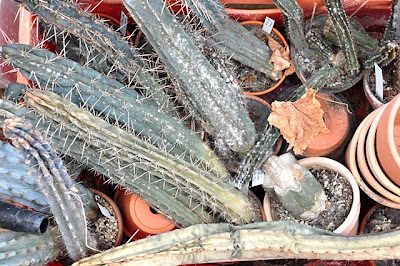
Decomposing Trichocereus plants
To put the death toll into perspective this is the coldest winter in 14 years in Denmark (followed by March, a month with the most extreme temperature fluctuations in 14 years, which were not very becoming to my struggling plants either). The frost set in just before Christmas and only lifted again in the beginning of March. The lowest temperatures measured in the area were as low as -15 C (5 F).

Outdoor temperature in late January
Once in a while short bursts of thaw set in quickly followed by frost (as indicated by the above graph), making the conditions even harder for the plants.

Outdoor temperature in mid February
The temperature measurements come from a semi-professional weather station located approximately 1.5 km (~ one mile) from where I grow my plants, so these temperatures are representative for those that my plants where exposed to.
To end on a positive note I expect the frost to have killed off many pests also (including red spider mites). Also, I got an affirmative confirmation that it is actually possible for peyote to survive rather extreme conditions in an unheated greenhouse in Denmark... and I got plenty of room for new plants ;-)
Sunday, February 21, 2010
Flowering Mammillaria meiacantha
I've had a few Mammillaria meiacantha plants (SB 249; Bernalillo County, New Mexico) growing in my cold house for the last couple of years. The plants thrive and last spring they embarked on a flowering spree.
Mammillaria meiacantha flower
One of the traits Steve Brack mentions for these plants in his seed catalogue are their huge red fruits, so I hope I succeeded in pollinating the flowers and will see some fruits soon.
Flowering Mammillaria meiacantha
I bought these plants for my unheated greenhouse because of their extreme cold tolerance. Steve Brack classifies Mammillaria meiacantha as being safe easily to -10F (-23C). So these plants, if any, ought to be able to survive the cold snap that has engulfed Denmark in snow and almost constant (severe) frost for more than two months now.
Mammillaria meiacantha is also known as Mammillaria heyderi v. meiacantha.
Monday, February 15, 2010
Flowering Mammillaria grahamii
In the late spring of '09 I bought a handful of Mammillaria grahamii (SB 507; Dona Ana County, New Mexico) from Kakteen-Haage. A few months after receiving the plants they flowered vigorously.
Mammillaria grahamii flower
The all-pink petals and filaments are beautifully contrasted by the bright yellow anthers and the dusty chartreuse stigma. I cross-pollinated several of the flowers and hope for seeds next year.
Flowering Mammillaria grahamii
I bought the plants for my cold house as Mammillaria grahamii is said to be relatively cold hardy. If they survive the current cold snap I guess they can survive anything (in relation to Danish winters, that is ;-) The current freezing conditions have lasted since before Christmas with outdoor temperatures as low as -15 C (5 F) so I hope the plants are not frozen solid.
Hooked Mammillaria grahamii spine
Seeing the Mammillaria grahamii spines up close it is easy to understand why it is also called fish-hook cactus ;-)
Sunday, September 28, 2008
Copenhagen Botanical Garden revisited
The first weekend of September I visited Copenhagen Botanical Garden again. As described earlier the garden has a cactus house open to the general public as well as a propagation house that you can't enter. Flowering and otherwise interesting plants are put on display close to the entrance of the propagation house so even though you can't enter you still have a chance to enjoy some of the gems hidden away inside this house. An example is the beautiful flowering Ariocarpus fissuratus pictured below.

Flowering Ariocarpus fissuratus

Ariocarpus fissuratus flower
Lots of interesting plants are on display inside the publicly accessible cactus house. I especially fell for the lone Ariocarpus retusus tucked away among some larger plants.
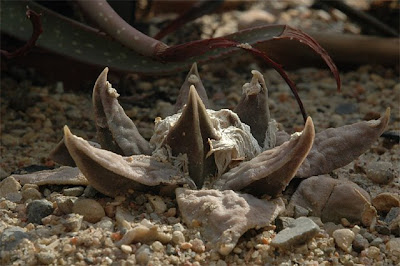
Ariocarpus retusus

Ariocarpus retusus seen from above
Another beauty growing among much larger plants is a (slightly dehydrated) Astrophytum asterias.

Astrophytum asterias
The cactus house holds a large collection of Mammillaria as for example this Mammillaria prolifera var. texana that certainly lives up to its name.

Mammillaria prolifera var. texana
Back in the propagation house a group of Strombocactus disciformis was also on display. The plants are growing in rocks mimicking their natural habitat.

Strombocactus disciformis
My previous post on the Copenhagen Botanical Garden & Museum featured several pictures of the greenhouses so I won't bring any here except for a photo showing the top of the main greenhouse reflected in the water lilly pool in front of it.

Greenhouse reflected in the water lilly pool
Sunday, November 11, 2007
Habitat photos – Lophophora etc.; second installment
The previous post featured habitat photos by Kauderwelsch who, in the meantime, has been kind enough to share more pictures at Wikimedia Commons. I’ve included a handful of his photos below.
The epidermis of this peyote cactus (Lophophora williamsii) is slightly bruised and looks like some animal nibbled on it but changed its mind after tasting the first couple of bitter bites (or maybe the bruises are just damage from the rocks scattered around the plant, but I like the “nibbling explanation” better ;-)

Peyote (Lophophora williamsii), near Monterrey, Nuevo León, México
Previously I haven’t been much into Mammillaria but seeing this magnificent picture of a flowering M. kraehenbuehlii has me wondering if I should grow some of these beautiful plants.

Flowering Mammillaria kraehenbuehlii
The next picture shows a Strombocactus disciformis growing in its typical habitat; nearly vertical, flaking limestone cliffs. It seems almost surreal that any plant is able to grow in this harsh biotope, but Strombocactus, Aztekium ritteri, and other species of cactus thrive in such conditions.
Strombocactus disciformis, near Vizarrón, Querétaro, México
The next two photos are a bit out of context (they are certainly not showing “small Mexican species”; and one is not even picturing a cactus ;-) I just fell for the beauty of the band of Cephalocereus columna-trajani standing tall against the background of towering clouds, and the sprawl of branches on that ancient looking Beaucarnea gracilis.

Cephalocereus columna-trajani,(syn. C. hoppenstedtii), near Tehuacán, Puebla, México

Adult specimen of Beaucarnea gracilis, Zapotitlán Salinas, Oaxaca, México
I have to visit México!
The photos are published under the terms of the GNU Free Documentation License. The original high resolution copies of the pictures are available here:
- Lophophora williamsii, near Monterrey, Nuevo León, México
- Flowering Mammillaria kraehenbuehlii
- Strombocactus disciformis, near Vizarrón, Querétaro, México
- Cephalocereus columna-trajani (syn. C. hoppenstedtii), near Tehuacán, Puebla, México
- Adult specimen of Beaucarnea gracilis, Zapotitlán Salinas, Oaxaca, México
Wednesday, October 31, 2007
Habitat photos – Lophophora etc.
A while ago I stumbled upon a handful of great Lophophora habitat photos published on Wikimedia Commons by Kauderwelsch.

Flowering Lophophora diffusa, near Vizarron, Quéretaro, Mexico

Group of Lophophora diffusa near Vizarron, Queretaro, Mexico

Peyote (Lophophora williamsii), Wirikuta near Wadley, San Luis Potosi, Mexico
Kauderwelsch has also made pictures of other cactus species available; a couple of examples are included below.

Ferocactus latispinus, Oaxaca, Mexico

Mammillaria kraehenbuehlii, Oaxaca, Mexico
Unfortunately no new images have been added by Kauderwelsch lately; based on the quality of the photos already contributed I would like to see more of his work.
The photos are published under the terms of the GNU Free Documentation License. The original high resolution copies of the pictures are available here:
- Flowering Lophophora diffusa, near Vizarron, Quéretaro, Mexico
- Group of Lophophora diffusa near Vizarron, Queretaro, Mexico
- Lophophora williamsii, Wirikuta, near Wadley, San Luis Potosi, Mexico
- Ferocactus latispinus, Oaxaca, Mexico
- Mammillaria kraehenbuehlii, Oaxaca, Mexico
Thursday, August 16, 2007
Copenhagen Botanical Garden & Museum
I spent part of my summer vacation in Copenhagen and naturally had to visit the Botanical Garden and Museum. The garden is located in the center of the city and has many visitors. Unlike most other gardens and parks in Copenhagen, the purpose of the botanical garden is research. Therefore, “it is not allowed to run, to ride a bicycle, climb the trees, stay on or walk on the lawns, pick the flowers or picnic.” These rules are a gross limitation on Danes who generally light bonfires and run around naked on lawns ;-)

The Conservatory
The botanical garden was established August 2, 1600, and has moved and changed during the centuries. The fourth and present incarnation of the garden was opened to the public on October 9, 1874, 274 years after the founding of the first botanical garden (the vanes on the conservatory roof date the construction to 1873).
The cactus and succulent plants have their own dedicated greenhouse in these wonderful settings. Facing the stairs leading to the main conservatory building (the palm house), the cactus and succulent house is located to the left of the stairs, one level lower than the palm house.
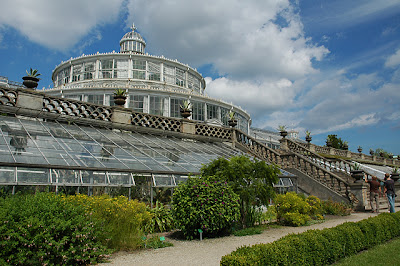
The cactus and succulent house
Inside the cactus house you’ll find an abundance of plants – both small globular types and huge columnar plants. It seems like theft of the smaller plants is a problem as they are protected by glass plates and the whole house is monitored by video.

Inside the cactus and succulent house
The plants all look vigorous and well tended for, as for example this group of flowering Astrophytum ornatum plants (for comparison you can check the A. ornatum growing in the Myriad Botanical Gardens, Oklahoma City).

Flowering Astrophytum ornatum

Astrophytum ornatum flower
A large, fat Astrophytum asterias was hiding in the shadows of the larger plants.

Astrophytum asterias
And a Mammillaria geminispina was displaying its last flowers along with a multitude of dark red fruits.
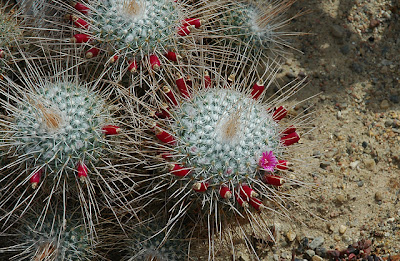
Mammillaria geminispina
Unfortunately I couldn’t find any Lophophora, Ariocarpus, or Strombocactus in the publicly accessible houses; but the garden also has houses that are not open to the public and reserved for experiments and plant propagation. Maybe it’s just wishful thinking, but I’m almost positive I glimpsed a collection of ariocarpi and a few lophs inside one of these houses.
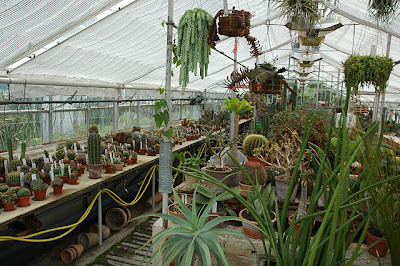
Propagation house – closed to the public
If you happen to be in Copenhagen a visit to the Botanical Garden and Museum is highly recommended. It’s a tranquil oasis situated in the center of a bustling city, and the historical conservatory buildings are beautiful in their own right (the garden was declared a preserved site on January 31, 1977). You might not find a lot of the rarer species in the houses open to the public, but the plants on display are abundant, well grown, and clearly marked.
All Time Most Popular Posts
-
Lophophora williamsii (peyote) populations have diminished in large areas of South Texas where peyoteros harvest the cactus for ceremonial ...
-
On various occasions I've been asked what growing media I'm using for my cactus plants. I don't have a set soil mix recipe as su...
-
Below is a list of retailers/nurseries selling cactus seed and plants. I've only listed vendors I've done business with. If you ar...
-
Most cacti are easily grown from seed - and with a little patience and care they can be grown into beautiful plants. Lophophora williamsi...
-
In last month’s post on the troubled Texan peyoteros I referred to Anderson’s article on the peyote situation in Texas. Given the importanc...
-
Yet another slightly off topic and probably not entirely politically correct post, but I couldn’t help noticing the similarity of my monstr...
-
Flowering stand of San Pedro cacti (Trichocereus pachanoi) To me the main draw of the San Pedro cactus ( Trichocereus pachanoi (syn. Ech...
-
In the June 2008 issue of the Cactus & Co magazine Jaroslav Šnicer, Jaroslav Bohata, and Vojtěch Myšák described a new Lophophora spec...
-
There seems to be an increased focus on the alarming Texas peyote situation. A couple of weeks ago the Houston Press published a mournful, i...
-
I spent two weeks working in Delhi, India during January. I had one weekend off and had planned to spend it in Delhi at my own leisure, but ...
